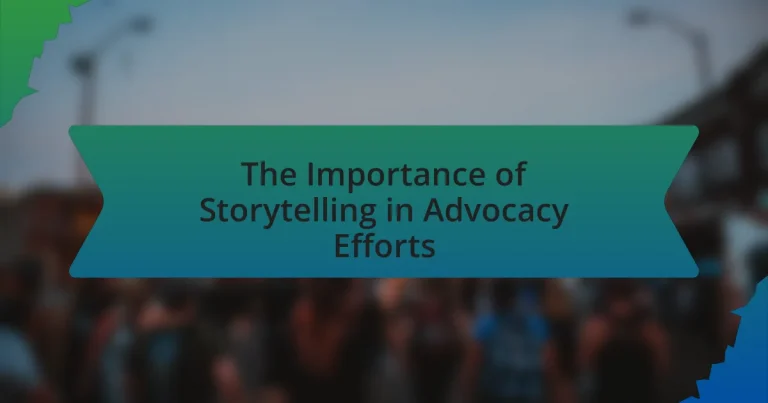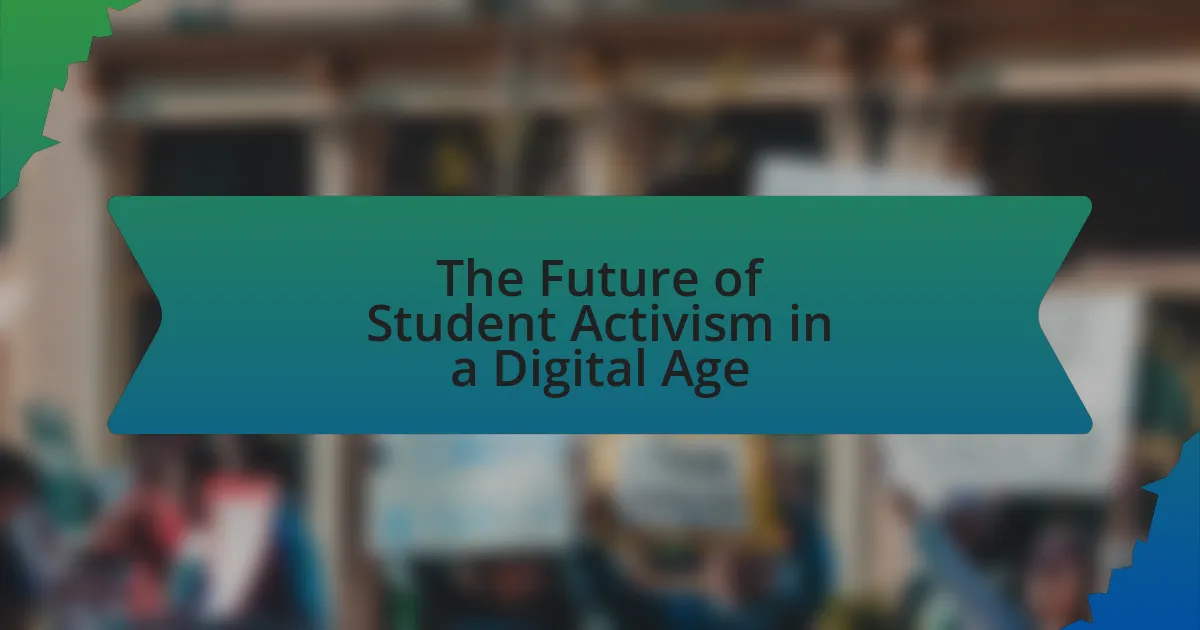The article focuses on the critical role of storytelling in advocacy efforts, emphasizing its ability to humanize complex social, political, and environmental issues. It outlines how narratives foster emotional connections, enhance empathy, and increase audience engagement, ultimately influencing public perception and mobilizing support. Key elements of compelling advocacy stories include emotional resonance, relatable characters, and clear calls to action. The article also discusses various types of storytelling, including personal narratives and digital storytelling, and highlights best practices for organizations to effectively implement storytelling strategies in their advocacy campaigns.
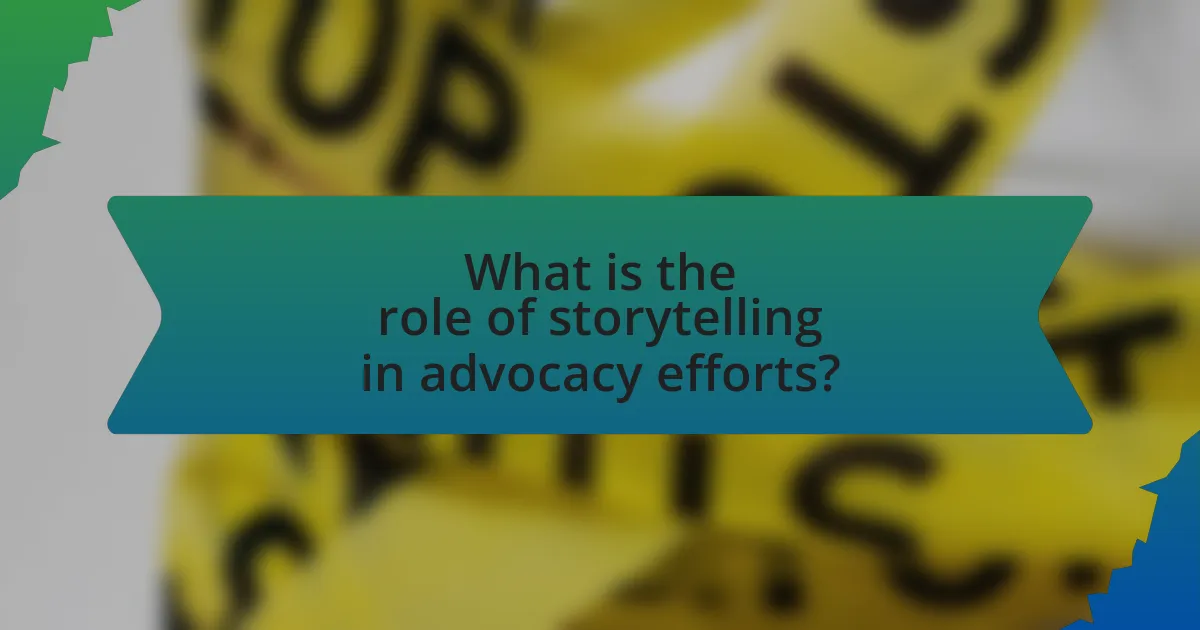
What is the role of storytelling in advocacy efforts?
Storytelling plays a crucial role in advocacy efforts by humanizing issues and making them relatable to the audience. Through narratives, advocates can convey complex social, political, or environmental issues in a way that resonates emotionally, fostering empathy and understanding. Research indicates that stories can increase engagement and retention of information; for instance, a study published in the journal “Psychological Science” found that narratives can enhance the persuasive impact of messages by up to 20%. This emotional connection can mobilize support, influence public opinion, and drive action, making storytelling an essential tool in effective advocacy.
How does storytelling influence public perception in advocacy?
Storytelling significantly influences public perception in advocacy by creating emotional connections that resonate with audiences. When advocates share personal narratives or compelling stories, they humanize complex issues, making them relatable and easier to understand. Research indicates that narratives can increase empathy and engagement; for instance, a study published in the journal “Science” found that stories can enhance the retention of information and motivate action by appealing to emotions rather than just facts. This emotional engagement can lead to a shift in public attitudes and behaviors, ultimately supporting advocacy goals.
What elements make a story compelling in advocacy contexts?
Compelling stories in advocacy contexts are characterized by emotional resonance, relatable characters, clear conflict, and a strong call to action. Emotional resonance engages the audience’s feelings, making them more likely to connect with the message. Relatable characters allow the audience to see themselves in the narrative, fostering empathy and understanding. Clear conflict presents the challenges faced, highlighting the urgency of the issue. A strong call to action motivates the audience to take specific steps toward change. Research indicates that narratives with these elements are more effective in influencing attitudes and behaviors, as demonstrated in studies by the Stanford Social Innovation Review, which found that stories can increase engagement and support for social causes.
How do emotions play a role in storytelling for advocacy?
Emotions are crucial in storytelling for advocacy as they create a connection between the audience and the message. This emotional engagement enhances empathy, making the audience more likely to support the cause. Research indicates that stories that evoke strong emotions, such as compassion or anger, can significantly influence attitudes and behaviors. For instance, a study published in the journal “Psychological Science” found that emotionally charged narratives can lead to increased willingness to donate to charitable causes, demonstrating the power of emotional storytelling in advocacy.
Why is storytelling considered a powerful tool in advocacy?
Storytelling is considered a powerful tool in advocacy because it effectively engages audiences on an emotional level, making complex issues relatable and memorable. This emotional connection fosters empathy, which can drive action and support for a cause. Research indicates that narratives can increase information retention by up to 65%, compared to facts alone, as demonstrated in studies by the University of California, Berkeley. Furthermore, storytelling can humanize abstract concepts, allowing advocates to illustrate the real-life impact of policies or social issues, thereby motivating individuals to participate in advocacy efforts.
What psychological effects does storytelling have on audiences?
Storytelling has significant psychological effects on audiences, primarily by enhancing empathy and emotional engagement. Research indicates that narratives can activate brain regions associated with emotional processing, leading to a deeper understanding of others’ experiences. For instance, a study published in the journal “Cognitive Science” by Paul Zak found that stories can increase oxytocin levels, a hormone linked to empathy and social bonding, thereby fostering a connection between the storyteller and the audience. Additionally, storytelling can influence attitudes and behaviors, as evidenced by a meta-analysis in “Psychological Bulletin” by Green and Brock, which demonstrated that narratives can effectively change beliefs and motivate action, particularly in advocacy contexts.
How does storytelling enhance message retention in advocacy campaigns?
Storytelling enhances message retention in advocacy campaigns by creating emotional connections that make the message more memorable. When narratives are used, they engage the audience’s emotions and imagination, leading to deeper cognitive processing. Research indicates that stories can increase information retention by up to 22 times compared to facts alone, as demonstrated in a study published in the journal “Psychological Science” by researchers from the University of California, Los Angeles. This emotional engagement not only aids in memory recall but also fosters empathy, making the audience more likely to support the cause being advocated.
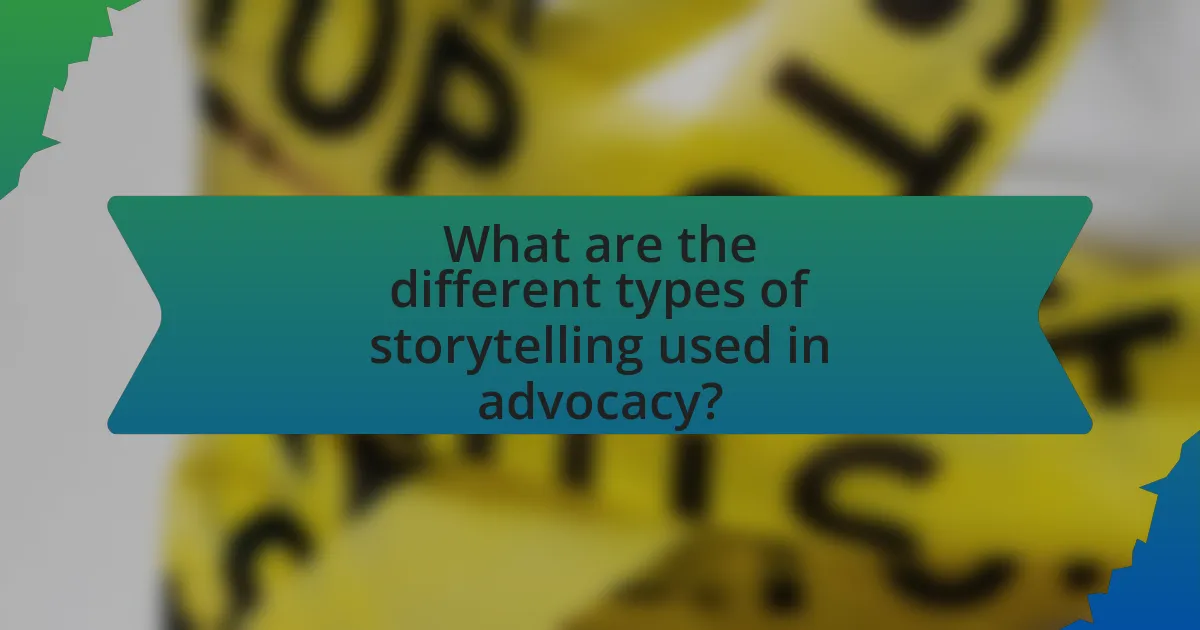
What are the different types of storytelling used in advocacy?
Different types of storytelling used in advocacy include personal narratives, data-driven stories, and collective stories. Personal narratives focus on individual experiences to evoke empathy and connect emotionally with the audience, making the issue relatable. Data-driven stories utilize statistics and research findings to provide a factual basis for the advocacy, enhancing credibility and persuading stakeholders through evidence. Collective stories highlight shared experiences within a community or group, fostering a sense of solidarity and collective action. Each type serves a distinct purpose in engaging audiences and driving advocacy efforts effectively.
How do personal narratives impact advocacy efforts?
Personal narratives significantly enhance advocacy efforts by fostering emotional connections and increasing relatability. When individuals share their personal experiences, they humanize complex issues, making them more accessible to a broader audience. Research indicates that stories can evoke empathy, which is crucial for mobilizing support; for instance, a study published in the journal “Psychological Science” found that narratives can lead to greater engagement and willingness to act on social issues. By illustrating the real-life implications of policies or social injustices, personal narratives can effectively influence public opinion and drive advocacy campaigns.
What are the benefits of using personal stories in advocacy?
Using personal stories in advocacy enhances emotional connection, increases relatability, and fosters engagement among audiences. Personal narratives humanize issues, making them more accessible and compelling, which can lead to greater awareness and support for causes. Research indicates that storytelling can significantly influence attitudes and behaviors; for instance, a study published in the journal “Health Communication” found that narratives can increase empathy and understanding, leading to more supportive actions. Additionally, personal stories can effectively illustrate the real-world impact of policies, making abstract concepts tangible and motivating individuals to take action.
How can organizations effectively collect and share personal narratives?
Organizations can effectively collect and share personal narratives by implementing structured storytelling initiatives that encourage participation and utilize digital platforms for dissemination. Structured initiatives, such as workshops or interviews, create a safe environment for individuals to share their experiences, ensuring diverse voices are represented. Digital platforms, including social media and dedicated websites, facilitate broader reach and engagement, allowing narratives to resonate with wider audiences. Research indicates that storytelling can enhance empathy and understanding, making it a powerful tool in advocacy efforts, as evidenced by studies showing that narratives can significantly influence public opinion and policy change.
What role does digital storytelling play in modern advocacy?
Digital storytelling serves as a powerful tool in modern advocacy by effectively conveying messages and mobilizing support for social causes. It allows advocates to share personal narratives and experiences, making complex issues relatable and emotionally engaging for audiences. Research indicates that stories can increase empathy and understanding, which are crucial for driving social change. For instance, a study published in the journal “Communication Research” found that narratives significantly enhance audience engagement and retention of information, leading to greater advocacy impact. Thus, digital storytelling not only amplifies voices but also fosters community and action around critical issues.
How can social media amplify storytelling in advocacy campaigns?
Social media amplifies storytelling in advocacy campaigns by providing a platform for widespread dissemination and engagement. It allows advocates to share personal narratives, visual content, and real-time updates, which can evoke emotional responses and foster community support. For instance, campaigns like #MeToo and #BlackLivesMatter have utilized social media to share powerful stories that resonate with audiences, leading to increased awareness and mobilization. Research indicates that storytelling on social media can enhance message retention and influence public opinion, as evidenced by a study from the Stanford Graduate School of Business, which found that narratives are more persuasive than statistics alone.
What tools are available for creating impactful digital stories?
Various tools are available for creating impactful digital stories, including Adobe Spark, Canva, and StoryMapJS. Adobe Spark allows users to create visually appealing graphics and videos with ease, making it suitable for storytelling. Canva offers templates and design elements that help users craft engaging narratives through visuals. StoryMapJS enables the integration of maps with narratives, enhancing the storytelling experience by providing geographical context. These tools are widely recognized for their user-friendly interfaces and capabilities, making them effective for advocacy efforts in storytelling.
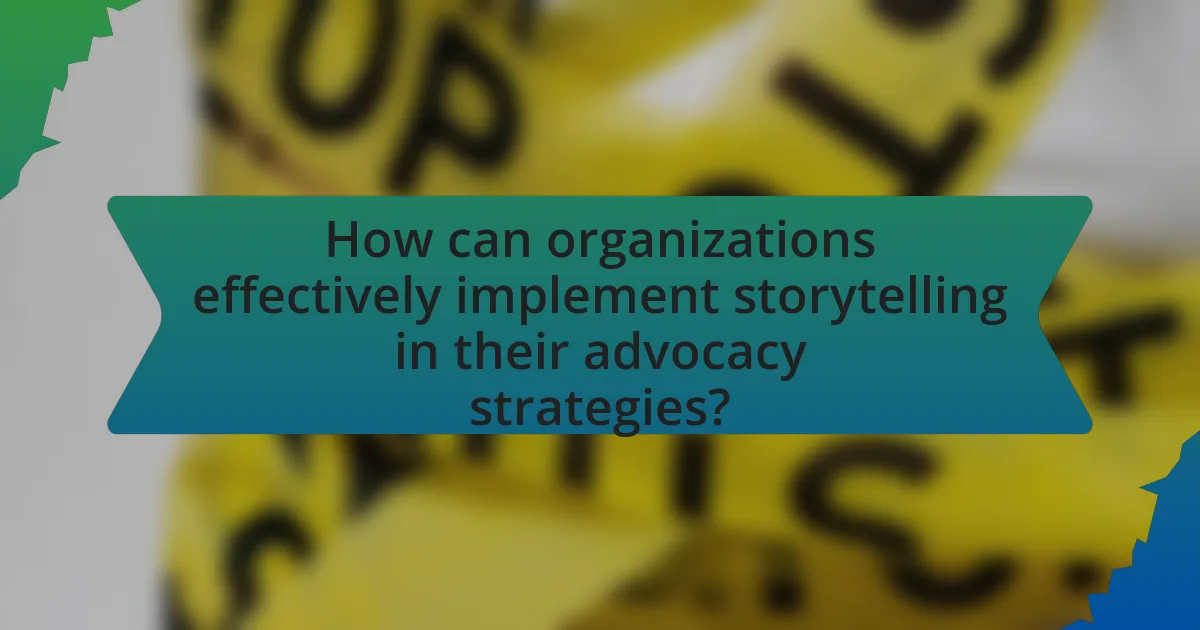
How can organizations effectively implement storytelling in their advocacy strategies?
Organizations can effectively implement storytelling in their advocacy strategies by crafting narratives that resonate emotionally with their target audience. This involves identifying relatable characters, presenting challenges, and showcasing solutions that align with the organization’s mission. For instance, a study by the Stanford Graduate School of Business found that stories are 22 times more memorable than facts alone, highlighting the power of narrative in influencing public perception and engagement. By integrating personal testimonials and real-life examples, organizations can create compelling stories that not only inform but also inspire action, thereby enhancing their advocacy efforts.
What best practices should organizations follow when crafting advocacy stories?
Organizations should focus on authenticity, clarity, and emotional connection when crafting advocacy stories. Authenticity ensures that the narrative reflects genuine experiences and values, which builds trust with the audience. Clarity involves presenting the message in a straightforward manner, avoiding jargon to enhance understanding. Emotional connection is crucial as it engages the audience on a personal level, making the story more relatable and impactful. Research indicates that stories that evoke emotions can increase message retention by up to 65%, demonstrating the effectiveness of this approach in advocacy efforts.
How can organizations ensure their stories resonate with diverse audiences?
Organizations can ensure their stories resonate with diverse audiences by actively engaging in audience research and incorporating inclusive narratives. By understanding the cultural backgrounds, values, and experiences of various demographic groups, organizations can tailor their messaging to reflect the diversity of their audience. For instance, a study by the Pew Research Center found that 61% of Americans believe that diverse representation in media leads to a better understanding of different cultures. This highlights the importance of using relatable characters and scenarios in storytelling that reflect the audience’s realities, thereby fostering connection and empathy.
What common pitfalls should be avoided in advocacy storytelling?
Common pitfalls to avoid in advocacy storytelling include lacking a clear message, failing to connect emotionally with the audience, and neglecting to provide actionable steps. A clear message ensures that the audience understands the core issue, while emotional connections can drive engagement and empathy. For instance, research shows that stories that evoke emotions are 22 times more memorable than facts alone. Additionally, providing actionable steps empowers the audience to participate in the advocacy effort, making the storytelling more effective.
What are some successful examples of storytelling in advocacy?
Successful examples of storytelling in advocacy include the “It Gets Better” campaign, which effectively used personal narratives from individuals to combat bullying and promote acceptance, resulting in widespread visibility and support for rights. Another example is the “Dove Real Beauty” campaign, which shared stories of women challenging beauty standards, leading to increased discussions around body positivity and self-esteem. Additionally, the “Humans of New York” project has highlighted individual stories that foster empathy and understanding for various social issues, influencing public opinion and policy discussions. These campaigns demonstrate how personal stories can resonate emotionally, mobilize communities, and drive social change.
How did specific campaigns leverage storytelling to achieve their goals?
Specific campaigns leveraged storytelling by creating relatable narratives that resonate emotionally with their target audiences, thereby enhancing engagement and support. For instance, the “It Gets Better” campaign utilized personal stories from individuals to convey messages of hope and resilience, effectively reducing stigma and fostering community support. This approach was validated by a 2011 study published in the Journal of Communication, which found that emotionally charged narratives significantly increased audience empathy and willingness to act. By framing their messages within compelling stories, these campaigns not only raised awareness but also mobilized individuals to participate in advocacy efforts, demonstrating the power of storytelling in achieving their goals.
What lessons can be learned from successful advocacy storytelling initiatives?
Successful advocacy storytelling initiatives demonstrate the power of emotional connection, clarity of message, and audience engagement. These initiatives show that stories that evoke empathy can significantly influence public opinion and policy decisions. For instance, research by the FrameWorks Institute indicates that narratives that humanize issues lead to greater understanding and support among audiences. Additionally, successful initiatives often utilize relatable characters and clear, concise messaging to ensure that the core message resonates with diverse audiences. This approach has been validated by case studies, such as the “It Gets Better” campaign, which effectively used personal stories to address youth issues, resulting in increased awareness and support.
What practical tips can enhance storytelling in advocacy efforts?
To enhance storytelling in advocacy efforts, focus on crafting a clear narrative that connects emotionally with the audience. Engaging storytelling should include relatable characters, a compelling conflict, and a resolution that highlights the advocacy message. Research indicates that narratives that evoke emotions can increase persuasion and retention of information, as demonstrated by a study published in the journal “Psychological Science,” which found that emotional stories are more memorable and impactful than factual presentations. Additionally, using visuals and personal anecdotes can strengthen the connection with the audience, making the advocacy message more relatable and powerful.
